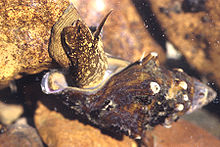Pleuroceridae
| Pleuroceridae | |
|---|---|

| |
Io fluvialis
| |

| |
| Athearnia anthonyi | |
| Scientific classification | |
| Domain: | Eukaryota |
| Kingdom: | Animalia |
| Phylum: | Mollusca |
| Class: | Gastropoda |
| Subclass: | Caenogastropoda |
| Superfamily: | Cerithioidea |
| Family: | Pleuroceridae Fischer, 1885 |
| Diversity[1][2] | |
| About 150 extant species | |
Pleuroceridae, common name pleurocerids, is a
Reproduction is
Evolution
There is very high level of mitochondrial
Populations of the pleurocerid species in the Old Appalachians (Virginia south to Georgia) are present on both sides of the Eastern Continental Divide, but there is no difference in the extent of intrapopulation heterogeneity on either side, and there is no evidence for cryptic speciation on either side either. Given the age of the Appalachians, it has been suggested that these populations may be extremely ancient, dating back to the Paleozoic when the initial Appalachian orogeny separated them, to the extent that any geographic signal in the test gene for the divergence estimates has ben lost. Levels of genetic divergence appear to be lower in the modern center for pleurocerid diversity (the Alabama and Coosa river systems) than in the Old Appalachians, indicating that the latter may represent the ancestral origin of pleurocerids.[4]
Distribution
As currently defined, this family is confined entirely to eastern North American fresh waters. Similar snails formerly classified with Pleuroceridae, but now assigned to other families are widespread in temperate and tropical parts of Southern and Eastern Asia,[citation needed] and Africa.[citation needed] Most require unpolluted rivers and streams, but a few are adapted to living in lakes or reservoirs.
Taxonomy
2005 taxonomy
The following two subfamilies have been recognized in the taxonomy of Bouchet & Rocroi (2005):[5]
- Pleurocerinae P. Fischer, 1885 - synonyms: Ceriphasiinae Gill, 1863; Strepomatidae Haldeman, 1864; Ellipstomatidae Hannibal, 1912; Gyrotominae Hannibal, 1912; Anaplocamidae Dall, 1921
- Semisulcospirinae Morrison, 1952 - synonym: Jugidae Starobogatov, Prozorova, Bogatov & Sayenko, 2004 (n.a.)
2009 taxonomy
Subfamily Semisulcospirinae within Pleuroceridae was elevated to family level Semisulcospiridae by Strong & Köhler (2009).[6]
Genera
Genera within the family Pleuroceridae are organized in the one subfamily only since 2009 and they include:
Pleurocerinae
- Pleurocera Rafinesque, 1818 - type genus of the family Pleuroceridae,[5]
- Elimia H. Adams & A. Adams, 1854 synonyms:Goniobasis Lea, 1862
- Athearnia Morrison, 1971
- † Gyrotoma Shuttleworth, 1845
- Io fluvialis(Say, 1825)
- Leptoxis Rafinesque, 1819
- Lithasia Haldeman, 1840
References
Further reading
- Tryon G. W. (1865). "Observations on the family Strepomatidae". American Journal of Conchology 1(2): 97–135.
- Tryon G. W. (1865). Synonymy of the species of Strepomatidae (melanians) of the United States; with critical observations on their affinities, and descriptions of land, fresh water and marine Mollusca. New York, Ballière Brothers, 520 Broadway, 100 pp., 2 plates.
- Graf, D. L. (2001). The cleansing of the Augean Stables, or a lexicon of the nominal species of the Pleuroceridae (Gastropoda: Prosobranchia) of recent North America, North Mexico. Walkerana. 12(27): 1-124
